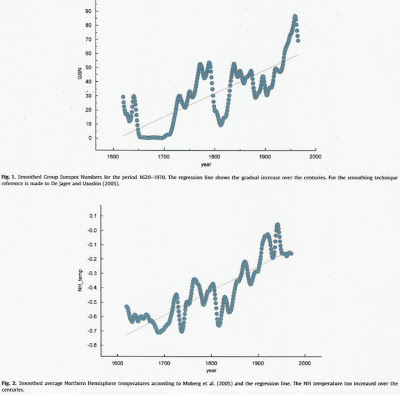A peer-reviewed paper published in the Journal of Atmospheric and Solar-Terrestrial Physics finds global warming over the 20th century “not significantly different” from warming episodes that occurred in earlier centuries. The paper finds that the increase in solar activity over the past 400 years explains the warming, without any need to search for a unique cause of late 20th century warming, such as greenhouse gas concentrations. The NIPCC website just posted this summary of the paper:
Authors de Jager and Duhau (2009) write that (1) “solar activity is regulated by the solar dynamo,” that (2) “the dynamo is a non-linear interplay between the equatorial and polar magnetic field components,” and that (3) “so far, in sun-climate studies, only the equatorial component has been considered as a possible driver of tropospheric temperature variations.”
In the present study, based on “direct observations of proxy data for the two main solar magnetic field components since 1844,” de Jager and Duhau derived “an empirical relation between tropospheric temperature variation and those of the solar equatorial and polar activities.”
When the two researchers applied the relation they derived to the period 1610-1995, they found a rising linear relationship for temperature vs. time, upon which are superimposed “some quasi-regular episodes of residual temperature increases and decreases, with semi-amplitudes up to ~0.3°C,” and they note that “the present period of global warming is one of them.”
Viewed in this light, it is easy to see, as de Jager and Duhau state, that “the amplitude of the present period of global warming does not significantly differ from the other episodes of relative warming that occurred in earlier centuries.” Why? Because the late 20th-century episode of relative warming, as they describe it, is merely “superimposed on a relatively higher level of solar activity than the others,” which gives it the appearance of being unique, when it really isn’t. Hence, there would appear to be no need to search for a unique cause of late 20th-century global warming (such as elevated atmospheric CO2 concentrations), since this latest warming is merely a run-of-the-mill relative warming, sitting atop a solar-induced baseline warming that has been in progress for the past four centuries.
 |
| Increased solar activity over the past 4 centuries (top graph) corresponds to reconstructed NH temperatures (bottom graph) |
de Jager, C. and Duhau, S. 2009. Episodes of relative global warming. Journal of Atmospheric and Solar-Terrestrial Physics 71: 194-198.
